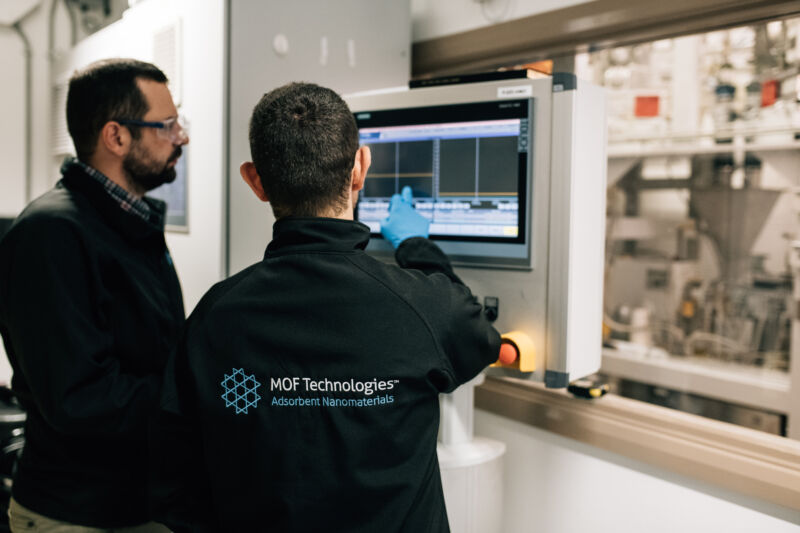The developing climate crisis is alarming countries across the globe, and has forced an urgent response from major industrialised nations. In April 2020, President Biden vowed to cut US emissions by at least 50% before 2030, while the UK recently reaffirmed its ambition to be ‘net zero’ by 2050. The achievability of these targets, however, will not only depend on limiting greenhouse gases through carbon capture but also a wholesale shift away from the use of fossil fuels.
This is defined as ‘energy transition’ – moving from current energy production and consumption practices towards a more efficient, low-carbon energy mix. Achieving this objective alongside economic development is certainly challenging, but most experts agree it’s feasible providing changes are made today and technological breakthroughs are fully exploited.
The discovery of metal-organic frameworks (MOFs) represents one such breakthrough. These super adsorbent materials can hasten the replacement of oil, coal and gas by solving many of the challenges associated with today’s alternative fuels. This includes hydrogen, a clean energy source that many believe will be central to a more sustainable future.
What are MOFs?
MOFs are a new class of crystalline super-adsorbent. Their highly porous nature means MOFs can be designed to capture, store and release specific gases through a careful selection of metals and linkers during the first stages of synthesis.
It is this bespoke quality, along with a high storage capacity, that gives MOFs so much promise. Other adsorbents, such as activated carbon and silica gel, cannot hold anywhere near as much medium and are unable to be used in such a selective way. MOFs, on the other hand, offer record-breaking porosities (up to 10,000m2/g) and can be developed to target anything from ethylene to carbon dioxide within complex gas mixtures.

Shaped MOF product
Hydrogen’s Promise
Hydrogen has long been seen as one of the best candidates for easing the world’s dependence on fossil fuels, due to its natural abundance and clean burning properties. Various sectors are targeting a transition to hydrogen energy, includingprivate transport. The phase out of diesel and petrol engines is already planned in many countries, with batteries and hydrogen fuel cells expected to take their place in the coming years. Major companies like Toyota have already introduced hydrogen-powered cars to the market but practical challenges, like onboard fuel storage and manufacturing costs, have slowed wider progress.
Domestic heating is another area where hydrogen is expected to play an important role, particularly as it can be piped through existing infrastructure. This will lower the cost of transitioning building stock but more importantly limit the boiler’s environmental impact, which is responsible for a high percentage of the home’s carbon emissions. Early trials have been promising but, much like the car industry, wider roll-out is dependent on access to pure sources of fuel.

Unlocking the Hydrogen Economy
Hydrogen fuel may still face a number of challenges before it can become society’s standard green energy source, but MOFs have proven versatile enough to offer solutions across the hydrogen economy.
Take storage, for instance. The low volumetric density of hydrogen sees it take up more space in a container when compared to other gases, meaning cryo-pressurised and liquified storage are necessary to make it practical. However, these methods are not the most secure or efficient ways to handle hydrogen as it’s highly flammable. Solid adsorbent materials like MOFs in comparison offer high porosity and a large surface area, meaning they can store far greater volumes of gas in a confined space without the need to increase pressure. Another significant advantage is the fast fill-up and discharge rates, which would be essential for supporting the transport industry.
Along with their storage potential, MOFs may provide the new levels of purity demanded by end-use applications. Fuel cells, for example, need an exceptionally pure supply of hydrogen to achieve optimum performance yet there are very few naturally occurring sources available. Today, the cheapest way to produce usablehydrogen gas is by purifying hydrocarbons and other compounds, but these processes tend to leave behind unwanted impurities.
To alleviate this issue, MOFs can be tuned to target specific gases and remove undesired molecules from gas mixtures. Their high stability also allows them to be recycled and reused multiple times, even in harsh industrial conditions. Early testing has proved favourable, with hydrogen now able to be purified from a range of sources, including in some of the most common post-production hydrogen gas mixtures. It goes to show MOFs are slowly opening the door to a cheap, effective means of generating pure hydrogen.
The ideas in this piece are just some of the ways MOFs are set to positively disrupt the energy transition. There are other key mentionable applications where these materials are set to transform how society gets its power. Among the most important of these is using MOFs as electrocatalysts to support water splitting – a process central to the large-scale production of green hydrogen. By now though it should be clear that these versatile products continue to deliver on their promise, offering arguably revolutionary progress. MOFs cannot solve the energy transition as a standalone solution – nor can any other technology – but they will play a critical role both today and in the future.
For more information, please contact Dr Conor Hamill, Chief Operating Officer of MOF Technologies or visit: https://www.moftechnologies.com/




